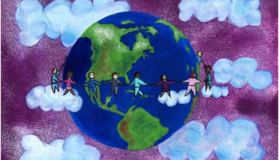Text C & D Culture and communication
1. Definition of intercultural communication
Intercultural communcation refers to the communcation between people from (two) different cultures. (textbook P.58)
2. Forms of intercultural communication
(1) international communication: takes place between nations and governments rather than individuals; it is quite formal and ritualized. e.g. communication at United Nations conference (textbook p. 59)
(2) interracial communication: occurs when the sender and the receiver exchanging messages are from different races. e.g. communication between black people and white people(textbook p. 59)
(3) interethnic communication: occurs when the sender and the receiver share common origin or heritage that is apt to influence family names, language, religion, values, and the like. e.g. communication between Chinese American and Japanese American (textbook p. 60)
(4) intracultural communication: refers to communication between and among members of the same culture. e.g communication between residents of Shannghai and Hangzhou. (textbook p. 60)


